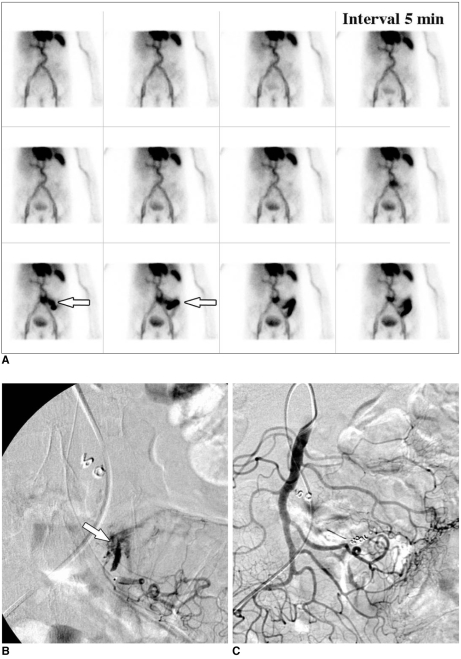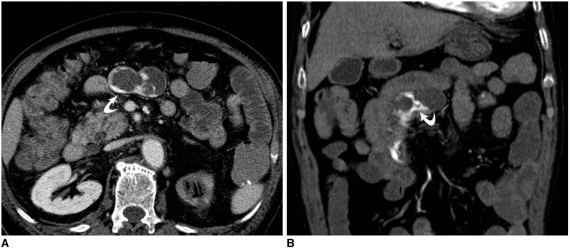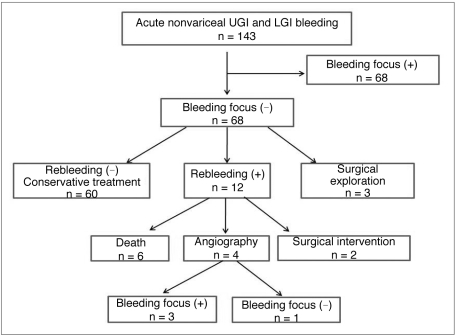Korean J Radiol.
2009 Aug;10(4):384-390. 10.3348/kjr.2009.10.4.384.
Angiographically Negative Acute Arterial Upper and Lower Gastrointestinal Bleeding: Incidence, Predictive Factors, and Clinical Outcomes
- Affiliations
-
- 1Department of Radiology, Asan Medical Center, University of Ulsan College of Medicine, Seoul 138-736, Korea. jhshin@amc.seoul.kr
- 2Department of Internal Medicine, Asan Medical Center, University of Ulsan College of Medicine, Seoul 138-736, Korea.
- KMID: 1777267
- DOI: http://doi.org/10.3348/kjr.2009.10.4.384
Abstract
OBJECTIVE
To evaluate the incidence, predictive factors, and clinical outcomes of angiographically negative acute arterial upper and lower gastrointestinal (GI) bleeding.
MATERIALS AND METHODS
From 2001 to 2008, 143 consecutive patients who underwent an angiography for acute arterial upper or lower GI bleeding were examined.
RESULTS
The angiographies revealed a negative bleeding focus in 75 of 143 (52%) patients. The incidence of an angiographically negative outcome was significantly higher in patients with a stable hemodynamic status (p < 0.001), or in patients with lower GI bleeding (p = 0.032). A follow-up of the 75 patients (range: 0-72 months, mean: 8 +/- 14 months) revealed that 60 of the 75 (80%) patients with a negative bleeding focus underwent conservative management only, and acute bleeding was controlled without rebleeding. Three of the 75 (4%) patients underwent exploratory surgery due to prolonged bleeding; however, no bleeding focus was detected. Rebleeding occurred in 12 of 75 (16%) patients. Of these, six patients experienced massive rebleeding and died of disseminated intravascular coagulation within four to nine hours after the rebleeding episode. Four of the 16 patients underwent a repeat angiography and the two remaining patients underwent a surgical intervention to control the bleeding.
CONCLUSION
Angiographically negative results are relatively common in patients with acute GI bleeding, especially in patients with a stable hemodynamic status or lower GI bleeding. Most patients with a negative bleeding focus have experienced spontaneous resolution of their condition.
MeSH Terms
Figure
Cited by 1 articles
-
Refractory Gastrointestinal Bleeding: Role of Angiographic Intervention
Ji Hoon Shin
Clin Endosc. 2013;46(5):486-491. doi: 10.5946/ce.2013.46.5.486.
Reference
-
1. Yoon W, Jeong YY, Shin SS, Lim HS, Song SG, Jang NG, et al. Acute massive gastrointestinal bleeding: detection and localization with arterial phase multi-detector row helical CT. Radiology. 2006; 239:160–167. PMID: 16484350.
Article2. van Leerdam ME, Vreeburg EM, Rauws EA, Geraedts AA, Tijssen JG, Reitsma JB, et al. Acute upper GI bleeding: did anything change? Time trend analysis of incidence and outcome of acute upper GI bleeding between 1993/1994 and 2000. Am J Gastroenterol. 2003; 98:1494–1499. PMID: 12873568.3. Prakash C, Zuckerman GR. Acute small bowel bleeding: a distinct entity with significantly different economic implications compared with GI bleeding from other locations. Gastrointest Endosc. 2003; 58:330–335. PMID: 14528203.4. Sanders DS, Perry MJ, Jones SG, McFarlane E, Johnson AG, Gleeson DC, et al. Effectiveness of an upper-gastrointestinal hemorrhage unit: a prospective analysis of 900 consecutive cases using the Rockall score as a method of risk standardization. Eur J Gastroenterol Hepatol. 2004; 16:487–494. PMID: 15097042.5. Leitman IM, Paull DE, Shires GT 3rd. Evaluation and management of massive lower gastrointestinal hemorrhage. Ann Surg. 1989; 209:175–180. PMID: 2783842.
Article6. Walsh RM, Anain P, Geisinger M, Vogt D, Mayes J, Grundfest-Broniatowski S, et al. Role of angiography and embolization for massive gastroduodenal hemorrhage. J Gastrointest Surg. 1999; 3:61–65. PMID: 10457326.
Article7. Abbas SM, Bissett IP, Holden A, Woodfield JC, Parry BR, Duncan D. Clinical variables associated with positive angiographic localization of lower gastrointestinal bleeding. ANZ J Surg. 2005; 75:953–957. PMID: 16336385.
Article8. Cynamon J, Atar E, Steiner A, Hoppenfeld BM, Jagust MB, Rosado M, et al. Catheter-induced vasospasm in the treatment of acute lower gastrointestinal bleeding. J Vasc Interv Radiol. 2003; 14:211–216. PMID: 12582189.
Article9. Hastings GS. Angiographic localization and transcatheter treatment of gastrointestinal bleeding. Radiographics. 2000; 20:1160–1168. PMID: 10903705.
Article10. Jae HJ, Chung JW, Jung AY, Lee W, Park JH. Transcatheter arterial embolization of nonvariceal upper gastrointestinal bleeding with N-butyl cyanoacrylate. Korean J Radiol. 2007; 8:48–56. PMID: 17277563.
Article11. Burke SJ, Golzarian J, Weldon D, Sun S. Nonvariceal upper gastrointestinal bleeding. Eur Radiol. 2007; 17:1714–1726. PMID: 17058080.
Article12. Dempsey DT, Burke DR, Reilly RS, McLean GK, Rosato EF. Angiography in poor-risk patients with massive nonvariceal upper gastrointestinal bleeding. Am J Surg. 1990; 159:282–286. PMID: 2305934.
Article13. Encarnacion CE, Kadir S, Beam CA, Payne CS. Gastrointestinal bleeding: treatment with gastrointestinal arterial embolization. Radiology. 1992; 183:505–508. PMID: 1561358.
Article14. Lang EV, Picus D, Marx MV, Hicks ME. Massive arterial hemorrhage from the stomach and lower esophagus: impact of embolotherapy on survival. Radiology. 1990; 177:249–252. PMID: 2399325.
Article15. Lang EK. Transcatheter embolization in management of hemorrhage from duodenal ulcer: long-term results and complications. Radiology. 1992; 182:703–707. PMID: 1535883.
Article16. Napoli A, Fleischmann D, Chan FP, Catalano C, Hellinger JC, Passariello R, et al. Computed tomography angiography: state-of-the-art imaging using multidetector-row technology. J Comput Assist Tomogr. 2004; 28:S32–S45. PMID: 15258492.17. Koval G, Benner KG, Rosch J, Kozak BE. Aggressive angiographic diagnosis in acute lower gastrointestinal hemorrhage. Dig Dis Sci. 1987; 32:248–253. PMID: 3493124.
Article18. Nicholson AA, Ettles DF, Hartley JE, Curzon I, Lee PW, Duthie GS, et al. Transcatheter coil embolotherapy: a safe and effective option for major colonic hemorrhage. Gut. 1998; 43:79–84. PMID: 9771409.19. Tan KK, Wong D, Sim R. Superselective embolization for lower gastrointestinal hemorrhage: an institutional review over 7 years. World J Surg. 2008; 32:2707–2715. PMID: 18843444.
Article20. Concha R, Amaro R, Barkin JS. Obscure gastrointestinal bleeding: diagnostic and therapeutic approach. J Clin Gastroenterol. 2007; 41:242–251. PMID: 17426461.21. Barnacle AM, Aylwin AC, Jackson JE. Angiographic diagnosis of inflammatory bowel disease in patients presenting with gastrointestinal bleeding. AJR Am J Roentgenol. 2006; 187:976–985. PMID: 16985146.
Article22. Bandi R, Shetty PC, Sharma RP, Burke TH, Burke MW, Kastan D. Superselective arterial embolization for the treatment of lower gastrointestinal hemorrhage. J Vasc Interv Radiol. 2001; 12:1399–1405. PMID: 11742013.
Article23. Lee CW, Liu KL, Wang HP, Chen SJ, Tsang YM, Liu HM. Transcatheter arterial embolization of acute upper gastrointestinal tract bleeding with N-butyl-2-cyanoacrylate. J Vasc Interv Radiol. 2007; 18:209–216. PMID: 17327553.
Article
- Full Text Links
- Actions
-
Cited
- CITED
-
- Close
- Share
- Similar articles
-
- Outcomes and complications of embolization for gastrointestinal bleeding
- Role of Multi-detector Row Computed Tomography for Localization of Acute Lower Gastrointestinal Bleeding
- Angiographic diagnosis and treatment of gastrointestinal bleeding
- Lower Gastrointestinal Bleeding: Is Urgent Colonoscopy Necessary for All Hematochezia?
- Clinical assessment and treatment algorithm for lower gastrointestinal bleeding




